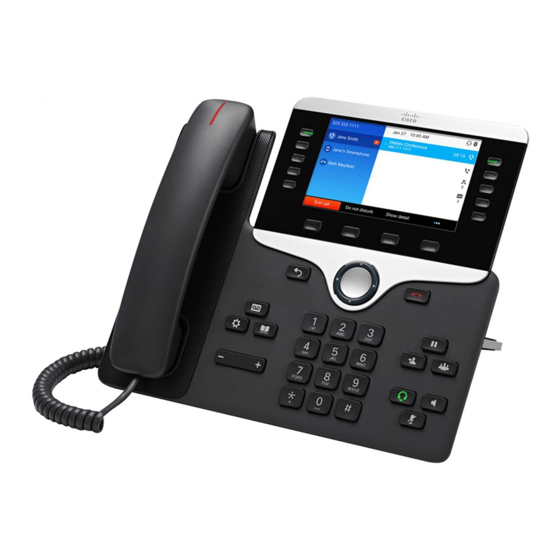
Cisco 8851 User Manual
Hide thumbs
Also See for 8851:
- Quick start manual ,
- Administration manual (310 pages) ,
- User manual (20 pages)
Summary of Contents for Cisco 8851
-
Page 1: Table Of Contents
Home PBXware SERVERware TELCOware SIPmon SIPProt Desktop & Mobile UADs Appliances From Bicom Systems Wiki Contents 1 Introduction 2 Video Tutorial 3 Requirements 3.1 Identifying Phone Model 3.2 Phone Firmware 3.3 DHCP Server 3.4 PBXware Version 4 Installation 4.1 Power Adapter 4.2 Find the Phone's IP Address 4.3 Reset to Factory Settings 5 Registering Device... -
Page 2: Video Tutorial
Phone Firmware Make sure that your phone is loaded with an appropriate firmware version, 11-3-3. To find out the software version for Cisco 8851, press the menu button, then type 71 DHCP Server Fully configured and operational DHCP server. -
Page 3: Pbxware Version
Connect the Ethernet cable between the Internet port on the phone and the network port on a router or switch to access LAN. Find the Phone's IP Address Find out your Cisco phone's IP Address Press the Settings button Type 72 to check the phone's IP address IP address should be displayed on the phone. -
Page 4: Registering Device
UAD settings Navigate to Settings: UAD. Make sure that Cisco UAD is enabled. To check the UAD status, click the Edit icon corresponding to the Cisco phone. Make sure Status is set to Active, Auto provisioning is set to No, and DHCP is set to Yes. - Page 5 Navigate to Extensions. Click Add Extension. The standard options window will be shown below. Select the Cisco phone model from the UAD select box. Select Location: Local or Remote. Local is for all Extensions registered on the LAN and Remote is for all Extensions registered from remote networks, WAN, Internet, etc.
- Page 6 An auto-generated PIN will allow access to voicemail and online self-care (OSC). Registering a Phone This section describes how to register a Cisco phone using Hostname or IP Address. Hostname or IP Address Log in to the phone's web administration interface Open a new browser window and enter the phone's IP address in order to access the phone's web administration interface login screen.
-
Page 7: Auto Provisioning
UAD settings Navigate to Settings: UAD. Make sure Cisco UAD is enabled. To check the UAD status, click the Edit icon corresponding to the Cisco phone. Make sure Status is set to Active, Auto provisioning is set to Yes, and DHCP is set to Yes. - Page 8 Click the Save button. Registering a Phone This section describes how to register a Cisco phone using DHCP, TFTP, or HTTP & HTTPS. The following topics are covered: DHCP TFTP or HTTP & HTTPS...
- Page 9 Click Voice at the top navigation menu. Click Provisioning found in the sub-menu. You can use TFTP or HTTP & HTTPS protocols in order to auto-provision your Cisco phone. TFTP This section describes how to use TFTP protocol in order to register the Cisco phone.
- Page 10 PBXware. HTTP & HTTPS This section describes how to use HTTP & HTTPS protocol in order to register the Cisco phone. NOTE: Your PBXware needs to be configured correctly for HTTP to work. Please make sure that HTTP username and HTTP passwords are set in the auto-provisioning section in 'Settings' - >...
-
Page 11: Configure Blf
PBXware. If everything is done as described above, you should have successfully registered your phone to PBXware. Configure BLF This section describes how to configure BLF (Busy Lamp Field) for Cisco 8851. Extension Settings Log in to the PBXware's web administration interface Open a new browser window and enter the IP address in order to access the PBXware's web administration login page.











